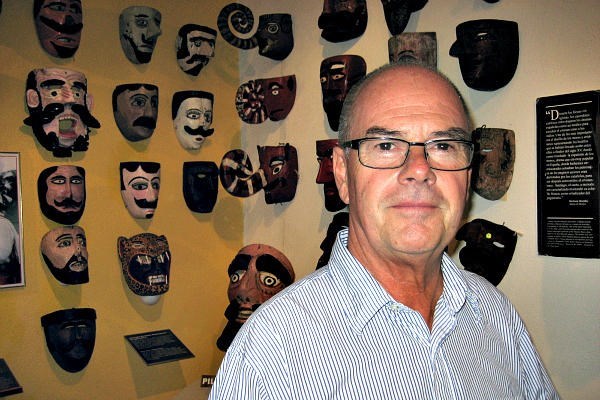 |
| Bill LeVasseur collects ritual masks of the indigenous peoples of Mexico. 'Some of the best compliments I get are from Mexicans,' he says. ' "Thank you for preserving this," they say. "This is part of our culture that we can't lose." '
Sara Miller Llana |
SAN MIGUEL DE ALLENDE, MEXICO
Bill LeVasseur never set out to become an ethnographer. Or a historian, anthropologist, migration specialist, or scholar of syncretism for that matter. He was an American advertising executive living in Mexico City who simply liked Mexican folk art.
But in the past two decades he has become all of those things, of sorts at least, amassing a collection of hundreds of Mexican masks from remote villages across the country that today he hangs on the walls of his museum in San Miguel de Allende. In doing so, he has singlehandedly preserved a piece of Mexican culture that few realize is still thriving today.
"Some of the best compliments I get are from Mexicans," he says. " 'Thank you for preserving this,' they say. 'This is part of our culture that we can't lose.' "
Masks have a crucial place in Mexican society, a pre-Hispanic custom that evolved but continued after conquest by the Spanish. Today, particularly in the thousands of tiny towns across the country, artisans still carve them for use in ceremonial dances to celebrate feast days and patron saints, most of it fusing elements of indigenous customs with Roman Catholic narrative.
Mr. LeVasseur stumbled upon masks innocently enough, as an expat on a stint abroad in Mexico City. A colleague gave him one as a present, piquing his curiosity. He started reading. He began going to art fairs to look for new renderings. Then he started traveling the switchbacks across the country.
"I felt like I was looking through a keyhole back 400 years in time," he says of his first experiences watching dancers in costume marching down the streets of dusty Mexican towns.
Today his collection, The Other Face of Mexico, spans the spectrum: representations of saints and devils, adorned with tigers and snakes, carved from mahogany or avocado wood. His one requirement: that they have previously been used in a dance or ritual, so that they are a living piece of history, not simply a piece of art.
LeVasseur has retired from his job and moved permanently to San Miguel de Allende, where he and his wife, in addition to the museum, run a bed-and-breakfast. But he still travels extensively, adding to his collection each year.
Taking five or six journeys annually, he has helped spread maskmaking knowledge across the country. Some towns are so small that that residents communicate and share crucial news via loudspeaker. He remembers showing up at one and paying the equivalent of a dollar for a town member to advertise that a man was there, interested in seeing what masks were available for sale. Artisans, carrying their most detailed work, walked in droves towards him. While many have spent lifetimes etching wood, a skill passed down from family to family, they have little idea of the art being created in the rest of the country. LeVasseur always bring photographs to share and leave with them.
At home in San Miguel de Allende, a popular destination for American retirees in central Mexico, his musem draws visitors from across the globe. But some of his most important visitors are the school children that come in busloads weekly.
The indigenous represent about a 10th of Mexico's population – there are more than 60 indigenous languages officially spoken throughout the country – and they preserve their culture not just through language but through their celebrations and the structure of their kinship. But school curricula treats indigenous culture as history, LeVasseur says. The students learn that the Spaniards conquered Mexico in the 16th century, and are pointed to the archeological ruins of Teotihuacan in central Mexico or the Maya ruins of Chichen Itza in the Yucatan Peninsula to learn about indigenous history. But it often stops there. "This is not just history," LeVasseur says, "it's contemporary."
The proceeds from the museum go to a local daycare, which looks after the children of indigenous women who sell crafts on the streets to tourists during the day. Eventually LeVasseur hopes that his collection ends up in a university in the United States. In the meantime it continues to grow, as artisans stay busy and the dances thrive, exposing everyone from a five-year-old Mexican to a Finnish housewife to a slice of culture that might otherwise remain isolated in the high mountains or tropical lowlands of Mexico.
Page created on 9/18/2012 12:00:00 AM
Last edited 1/4/2017 9:27:28 PM
